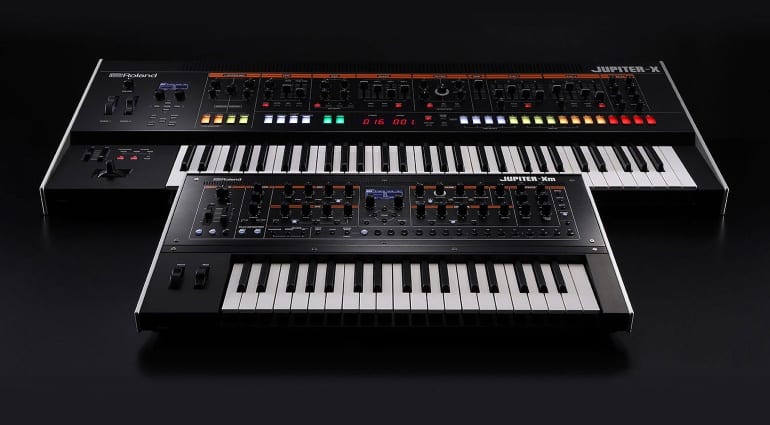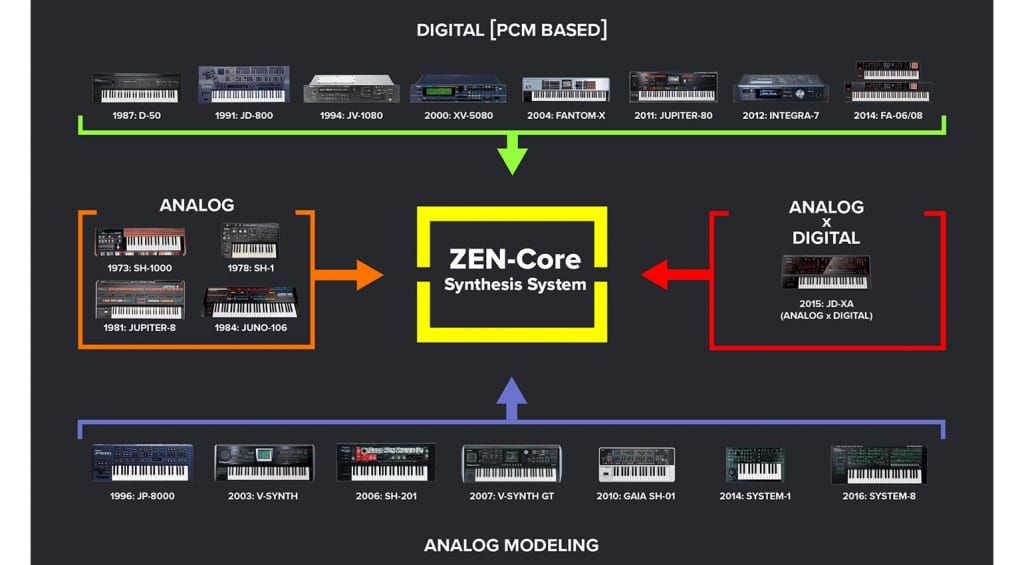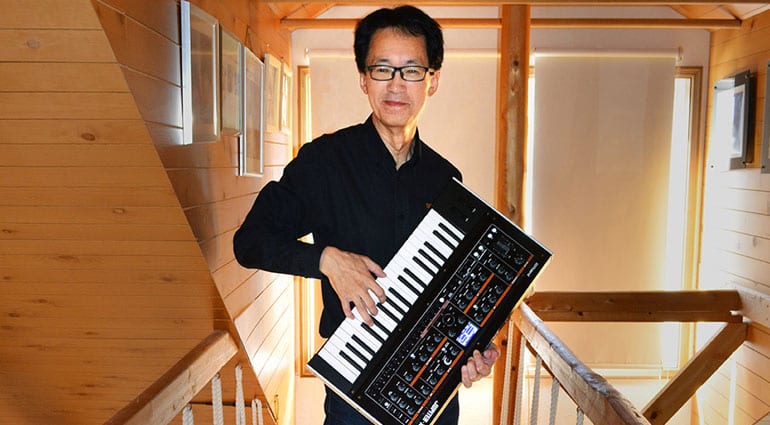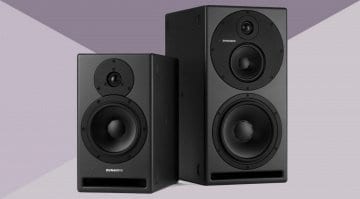NAMM 2020: Roland reveals ZEN-Core Synthesis System unifying technology
Roland are to reveal their ZEN-Core Synthesis System at the NAMM show. It’s a multi-timbral sound source with a virtual analog and PCM sound engine and DSP effects that can be found in the forthcoming Jupiter-X and some products we already know. It will ultimately enable sounds to be transferred between a whole range of Roland instruments.
ZEN-Core
It pulls together all the different forms of Roland synthesis by absorbing them into the ZEN-Core engine. That could be analog like the Juno-106 or PCM Digital like the JV-1080, a hybrid like the JD-XA and analog modelling like the System-8. It uses Analog Behaviour Modelling (ABM) to reproduce the characteristics and sound of every type of synthesizer as “Models” and serves them up with 32 note polyphony. It’s not to be confused with Analog Circuit Behaviour (ACB) which the models individual components and circuits of vintage Roland synths and is more suited to monophonic sounds and simple layers. ACM offers a more holistic and dynamic recreation which pushes it to the 32 notes. Roland suggests that you can use both modelling technologies.
ZEN-Core runs on proprietary system-on-a-chip called BMC or Behaviour Modelling Core and contains a large array of DSP and CPU core blocks and hardware logic. It’s this chip that enables Roland to build what they see as the ultimate synthesizer, that can be and play anything.
It integrates next-generation PCM and Virtual Analog, with advanced features such as new Virtual Analog oscillators, precisely modelled filters, ultra-fast and smooth envelopes and LFOs, high-resolution parameters, and expandability. The Jupiter-X uses the ABM expansion, the Fantom uses the V-Piano expansion.
But what’s particularly amazing about this ZEN-Core engine is that the sounds are compatible and can be shared across a growing number of Roland Instruments. Create a ZEN-Core based patch on the Jupiter-X and you can play it on the RD-88 Stage Piano or the AX-Edge Keytar. This sort of means, if I understand it correctly, that when you buy one ZEN-Core compatible synthesizer, you’ve bought them all.
There will of course be sound packs to expand the palette of your ZEN-Core compatible instrument.
Instruments that are already ZEN-Core compatible include the Jupiter-Xm, the MC-707, the MC-101 and the Fantom. The forthcoming Jupiter-X of course will be the showcase for this technology and we’ve also got the new RD-88 Stage Piano. This, for me, suddenly puts the Jupiter-Xm in the spot light as a massively expansive sound source and synthesizer. Or maybe the consider the little MC-101 groove box as a huge sound module. The mind boggles just a little bit.
Roland CEO Jun-ichi Miki
There’s an interview with Roland CEO Jun-ichi Miki where he talks about the development of the Jupiter-X and Xm and it’s a complete eye-opener. Flies in the face of much of the criticism of Roland that they’ve somehow lost the plot in terms of synthesizers. He explains some of the new ZEN-Core modelling like this:
Different from the base Virtual Analog of ZEN-Core, the ABM-powered “Model Bank” synths in the JUPITER-X and Xm reproduce the total character of specific vintage synths including the JUPITER-8, JUNO-106, JX-8P, and SH-101, all with incredible precision. For these synths, we did deep behavioral analysis of elements such as the filter’s curve, range, and response speed, which are different for each model, of course. We even recreate characteristics including oscillator drift driven by temperature changes. We actually put a physical temperature sensor inside the JUPITER-X and Xm to help with this!
The expandable ZEN-Core engine truly embodies all of Roland’s synthesizer know-how, and through the immense power of our BMC chip, can run multiple synthesis types including product-specific expansions plus DSP effects simultaneously and in real time. It truly is a breakthrough.
With the Jupiter-Xm he wanted to build a completely integrated dream synthesizer studio that you could take anywhere and be ready to make music at any time. That’s why it has batteries, speakers, an audio interface, mixing, DSP and Bluetooth. It’s designed to be absolutely ready-to-go.
And he finishes off with this response to those who want Roland to look to the past.
We are very aware of the very strong passion that synth fans have for the JUPITER-8, and some continue to wait for us to introduce a true analog version. This is something we do not plan to do. Our founder Mr. Kakehashi always said, “Never chase a ghost,” and I really understand his meaning. “Chasing the ghost” of the original JUPITER-8 or TR-808 does not make sense as we will never catch them, and this effort would not align with our vision for the future. Roland has developed many legendary products throughout our history that came from our drive to always design the future by applying the latest technology and our unique know-how from each era. This is our DNA which will never change.
I suddenly have a renewed interest in getting my hands on a Jupiter-Xm.
More information
2 responses to “NAMM 2020: Roland reveals ZEN-Core Synthesis System unifying technology”













“ACM offers a more holistic and dynamic recreation which pushes it to the 32 notes. ”
So now, what the heck is ACM? A mixture between ACB and ABM with 16 note polyphony? 😀
But I do have an actual question: What’s the difference in sound between ACB and ABM. More holistic and dynamic means what? More polyphony, but less analogueness?
But then:
If this whole schema up there means that I can run a V-Piano on the little MC-101 I would prepare to get excited. With what polyphony?
I pulled out as much information with as much clarity as I could find. They are different but how that works is unclear – and you can use both…. or either. My understanding is that the MC-101 has the complete ability to run the Zen-Core engine and so can have all the synths all the time. Why dont they just release a black box that does that? Hopefully things will become clearer with time.